The viewpoint of Garmin G3000 Autoland
| ✅ Paper Type: Free Essay | ✅ Subject: Aviation |
| ✅ Wordcount: 1776 words | ✅ Published: 14 May 2021 |
Abstract
Human factor is the cognitive ability of an individual’s performance in technological systems. Human cognition is a study of how humans gather knowledge and process any information. Perception, attention, memory, knowledge, comprehension, reasoning, learning, and decision making all are part of cognitive processing. This is a fascinating topic to study in this era of science and technology. Aviation has come a long way in a very short period with the blessing of modern science. From traditional six-pack to glass cockpit was quite the transition. The use of autopilot is not an exciting story anymore. With the advancement of technology, automation is becoming a big part of the aviation industry.
Automation is a collection of technology that can run by itself with the help of predesigned systems. A team of human factor scholars and hundreds of engineers have worked with Garmin to develop an automation project. They came up with Garmin G3000 Autoland. This system is perfectly capable to land a plane without any commends from the pilots. Risk assessment, decision-making, memory functions, knowledge forming, neuropsychology, use of language, perception, understanding, and attention were emphasized to build this design.
In 1929, Jimmy Dolittle flew an airplane by relying on the traditional cockpit. The traditional six-pack panel cockpit was safe enough to conduct flight operations until 1970. Later more complex aircraft with faster speed was manufactured and needed additional data on board for safety. Eventually, the glass cockpit came to the rescue.
Glass cockpit refers to the liquid-crystal display (LCD). It replaced the six-pack and has two flat-screen displays. The left-side screen is the primary flight display (PFD), which replaced the primary flight instruments. On the right side, the screen is a multi-function display (MFD) with additional helpful functions, including moving maps and weather information. Glass cockpit brings different display styles and increases in the automation system.
Automatically controlled operation of an apparatus, process, or system by mechanical or electronic devices that take the place of human labor is called automation (Escudier & Atkins, 2019). Automation reduces human interferences or interactions during flights. Autoland is the newest feature in aviation automation. Adopting the Autoland system might be the next step for the aviation world.
Risk Management Procedures
Risk management is a method to identify potentially hazardous situations to analyze and evaluate the relatedrisk. High-risk professionals go through risk management to check themselves and verify if they are fit for the task. For example, pilots go through risk management to assess their wellbeing. They ask themselves a few questions. Such as: Am I suffering from any illness? Have I taken any medication that would interfere my judgment or influence my alertness? Am I under unbearable stress? Did I consume any alcohol within the last 8 hours? If I did, would the alcohol level be more than .04% in my blood, or am I under the influence? Am I fatigued to go for the flight? Am I emotionally stable? Have I eaten?
After self-assessment, they verify the aircraft’s airworthiness, examine the minimum equipment list and performance charts. Airport and en-route weather, runway length, and conditions are next in the check. Lastly, the pilots verify if they can conduct a safe flight from point A to point B and ask themselves if they are taking off under any external pressure. Such as meeting with family or company pressure.
Even after all these checks – pilots are humans. The punishment for whatever mistake made in an airplane should not be the ultimate one. Not for the pilots and certainly not for the passengers (Boatman, 2020). Even after taking the preflight self-assessment if the pilot becomes incapacitated – Garmin G3000 will be able to bring the pilot and passengers to safety by landing the plane to the nearest airport.
Garmin G3000 Autoland can detect incapacitated pilot. The system can be activated with a press of a button by passengers as well. Pilots will brief the passengers about the facility in the passenger briefing segment of the checklist before the takeoff. Different manufacturers are putting the button on distinct accessible places. Cirrus Vision Jet and Piper M600 will be first with the Emergency Autoland feature. Cirrus Vision Jet making Autoland button in red and Piper M600 is designing to make it guarded.
Figure 1
Guarded Autoland button and MFD display of G3000 when the Autoland is activated
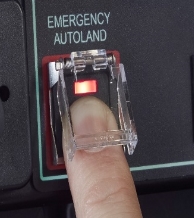
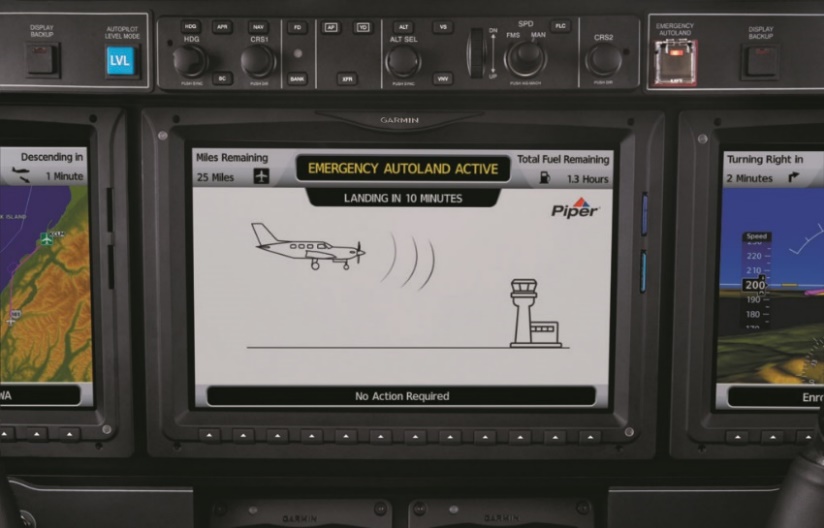
Decision Making Process of Autoland
Decision-making is a set of choices after considering the given information for the situation, evaluating the alternatives, and finally deciding. Garmin G3000 has the preprogrammed capability to complete the tasks via pattern recognition of an inactive pilot. It automatically activates itself when there are no inputs from the pilots. Even though the system does not have the capability to understand pilot or passengers’ emotional distress truly. It is designed to announce what the system is doing by announcing to the cockpits. The system is designed to use simple English, and the female voice has been used to prerecord all the announcements and instructions in a friendly tone to comfort. Garmin G3000 Autoland also reports/inform the Air traffic control (ATC) automatically about the emergency auto-landing. Passengers can talk to the control tower, but it is not necessary. If the passenger wants to talk to an air traffic controller, they can activate the microphone. The passengers’ microphone design is similar to the smartphone voice command activation approach to give easy access to the non-aviator user.
Table 1
The decision-making process of Autoland and the cockpit display message 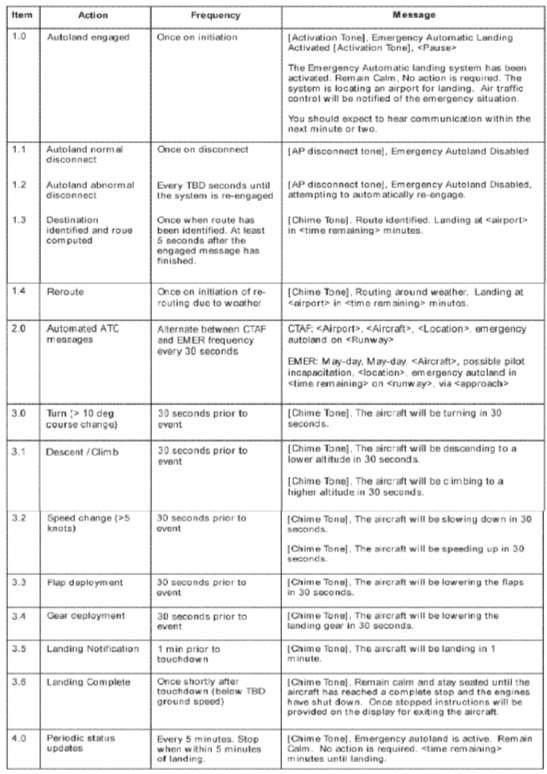
Garmin G3000 Autoland
The Garmin G3000 system does a set of calculations, takes a set of decisions, identifies the nearest airport with global positioning system (GSP), verifies the available runway to land, and checks the width, length, and surface condition. It also calculates the fuel remaining and crosswind component. Terrain/obstacles and general weather information are part of this assessment. The system announces all the actions via the cockpit voice annunciator. A passenger with zero flight experience will be able to understand the progress report of the G3000 Autoland. It shows the aircraft’s current position, the destination airport, the distance from the runway, current height, and altitude.
Table 2
Garmin G3000 Autoland announce all the steps for the distressed passengers
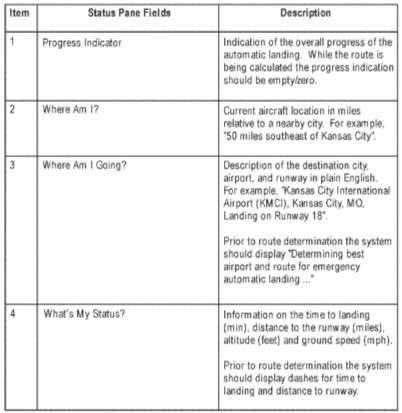
When in the single crew environment and the only pilot on board is incapacitated, it is life-threatening for the pilot and passengers. 9/11 taught us how much suffering an uncontrolled flying machine could do. Autoland comes to the rescue in those situations and land at the nearest airport safely. There was a plane crash in 1999. A Learjet N47BA took off from Florida with a promising US golfer Payne Stewart. This flight cabin pressure was designed to create artificial altitude pressure for the passenger comfort to inhale oxygen comfortably. Unfortunately, the flight had rapid depressurization, and as a result, the pilot’s cognitive ability was compromised within a few seconds—the pilots and passengers on board of that jet, pass out of oxygen deprivation.
Figure 2
Path of Learjet N47BA
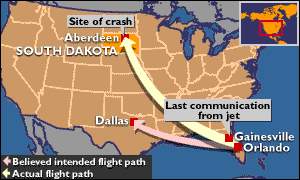
All four passengers and both pilots died before the crash. The plane run out of fuel and crash in South Dakota (NTSB, 2000). Garmin’s new Autoland system could come to save the day in a situation like this. Learjet N47BA’s flight plane took off from Orlando, Florida and the destination was Dallas Love Field, Texas. Autopilot was activated, and this ghost plane flew for four hours until the fuel runs out. If the plane was Autoland equipped, the aircraft would have started descending towards the closest runway and could have saved all six souls on board from the catastrophe. The airplane would have decent down to lower altitude as well, and natural oxygen from the outside atmosphere could have woken the pilots or become conscious enough to use the oxygen mask and take over the jet’s control.
Figure 3
Cirrus Vision Jet and Piper M600 will be first with Emergency Autoland.

The preprogrammed memory functions organized and utilized of the program to come all together in this design of Garmin G3000 Autoland. Cognitive skills’ core capabilities are sustained attention, response inhibition, speed of information processing, cognitive flexibility/control, multiple simultaneous attention, working memory, category formation, and pattern recognition. Attention is a vital ingredient part of this design. The machine does not get tired or distress under external pressure like humans; thus, they can be designed to have sustained attention patterns.
Conclusion
In the single crew cockpit, the Autoland system can detect pilot inactivity and take over the control to bring the plane and pilot to safety (Haskins et al., 2017). For example, if the pilot is suffering from hypoxia and later gain consciousness while descending, they can overwrite the Autoland and contact the appropriate frequency to state his ability and current status. Aviate, navigate, and communicate is still the key in this design. It will also give a safety boast to the solo pilots and give passengers of zero flight experience peace of mind. GPS approach, sufficient runway length, and competent weather is all it takes for the Autoland system to land safely. The system is intelligent enough to bleed altitude or airspeed if the aircraft is flying fast or high. If necessary, the system initiates to hold to avoid other air traffic. The system extends the flaps and landing gear when appropriate and safe. Garmin G3000 Autoland’s only limitation is that the system cannot land in an airport without a GPS approach and vertical guidance facility. Currently, this system will work anywhere in the world except China, Russia, Central Africa. Garmin G3000 Autoland might be the next step to develop a safer flight operation for the future.
References
Cannon, J. R., & Richey, F. D. (2012). Practical applications in business aviation management. Lanham, Maryland; Plymouth, England
Cirrus aircraft vision jet gets FAA certification. (2016). Business Insight: Essentials. Entertainment Close-Up.
Escudier, M., & Atkins, T. (2019). A dictionary of mechanical engineering. Retrieved from https://ebookcentral.proquest.com
Haskins, S. K., Duerksen, N. J., Patel, B. N., Tran, E., Lombardo, J., Barber, C. E.
(2017). Emergency Autoload System. Garmin International, Inc. Retrieved from https://www.freepatentsonline.com/y2017/0249852.html
Naidoo, P. (2010). Airline pilots’ perceptions of advanced flight deck automation: Aviation human factors analysis. Saarbrücken, Germany: Lambert Academic Publishing (LAP)
National Transportation Safety Board. (1991). Aircraft accident report: Avianca, the airline of Columbia Boeing 707-321B, HK2016, fuel exhaustion, cove neck. Washington, D.C.
National Transportation Safety Board. (2014). Descent below visual glidepath and impact with seawall, Asiana Airlines Flight 214, Boeing 777-200ER, HL7742, San Francisco, California. Washington, D.C.
Risen, T. (2019). Uber tests helicopter ride sharing in New York. Reed Business Information Ltd.
Schwarz, F. D. (2004). 1929: Flying blind: jimmy dolittle made first flight on instruments. American Heritage, 55(4), 72.
Cite This Work
To export a reference to this article please select a referencing stye below:
Related Services
View allDMCA / Removal Request
If you are the original writer of this essay and no longer wish to have your work published on UKEssays.com then please click the following link to email our support team:
Request essay removal


